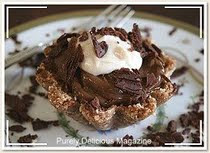 " Cultured food was a healthy mainstay in the diets of our ancestors. Only a minimal portion of their foods were even cooked -- raw foods, full of live enzymes made up the majority of their diet. Our "modern" methods of pasteurization and adding chemicals to speed fermentation of products like yogurt and cheese have killed these once enzyme rich foods and converted them to substances (poisons, if you will) that disable our digestion and ultimately endanger our health.
" Cultured food was a healthy mainstay in the diets of our ancestors. Only a minimal portion of their foods were even cooked -- raw foods, full of live enzymes made up the majority of their diet. Our "modern" methods of pasteurization and adding chemicals to speed fermentation of products like yogurt and cheese have killed these once enzyme rich foods and converted them to substances (poisons, if you will) that disable our digestion and ultimately endanger our health.Cultured foods help reestablish the natural balance of our digestive system.
Through the ancient art of fermentation, these foods are partially digested by friendly enzymes, fungi, and good bacteria -- making their nutrients readily available with little work for your body. In addition to enhanced flavor and nutrition, cultured foods also offer a multitude of medicinal rewards by:
*alleviating digestive disorders - the flora in living cultured foods form a "living shield" that covers the small intestine's inner lining and resists pathogenic organisms like E.coli, salmonella and an unhealthy overgrowth of yeast
*strengthening immunity with increased antibodies that fight off infectious disease
*effectively impacting the behavior of children with autism and ADD
*regulating weight and appetite by reducing cravings for sugar, soft drinks, bread and pasta.
(NOTE: this is the "short" list of benefits; testimonials abound regarding the health benefits of fermented, probiotic foods...and there are other foods bsides the fermented veggies, ie yogurt, that are loaded with probiotics - or you can take capsules)
When you eat raw cultured vegetables loaded with enzymes -- you give your body an opportunity to make enzymes to rejuvenate itself instead of wasting a large portion of your enzymes digesting food." (borrowed from Mercola.com - saves a lot of rewording!)
You can make cultured vegetables by shredding cabbage or a combination of cabbage and other vegetables and then packing them tightly into an airtight container -- leaving them to ferment at room temperature for several days or longer. During fermentation, the friendly bacteria are rapidly reproducing and converting sugars and starches to lactic acid.
Once the initial process is over, slow down the bacterial activity by putting the cultured veggies in the refrigerator. The cold greatly reduces the fermentation, but will not stop it completely. Even if the veggies sit in your refrigerator for months, they will not spoil; instead they become more appetizing over time -- much like a fine wine.
The beneficial bacteria naturally present in the vegetables promptly lower the pH, making a more acidic environment so the bacteria can reproduce. The vegetables become soft, tasty, and slightly "pickled". The enzymes in cultured vegetables will also help digest other foods eaten with them, aiding in the breakdown of both carbohydrates and proteins.
OK, having all that info under my hat, on to the fun part: making this wonder food!
Having three lusciously purple cabbage lounging in the garden, my first kraut project with the fermentation jar from Mike Snyder (http://store.therawdiet.com/pisaandkimch.html) was a given. The instructions are simple and with the help of my processor, the prep was fast. I used just one head, about 3 pounds.
 Filling the jar with the salted, finely shredded cabbage was reminescent of my mom and dad pounding cabbage in the big crock to make the wonderful sauerkraut of my childhood memory. My project will produce a fraction of the big crock, but the main difference is, that my kraut will be eaten "fresh" (refridgerated), while the crocked kraut (careful, there, that's a dangerous turn of phrase...) was` canned to perserve it for any length of time. No longer a "raw food" and no live enzymes...
Filling the jar with the salted, finely shredded cabbage was reminescent of my mom and dad pounding cabbage in the big crock to make the wonderful sauerkraut of my childhood memory. My project will produce a fraction of the big crock, but the main difference is, that my kraut will be eaten "fresh" (refridgerated), while the crocked kraut (careful, there, that's a dangerous turn of phrase...) was` canned to perserve it for any length of time. No longer a "raw food" and no live enzymes... This rather peculiar looking jar is a fermentation design that keeps the good guys in and the bad guys out. I purchased it for a modest price ($15 for the half-gallon jar) from a former almost-neighbor in Portland, Oregon
This rather peculiar looking jar is a fermentation design that keeps the good guys in and the bad guys out. I purchased it for a modest price ($15 for the half-gallon jar) from a former almost-neighbor in Portland, Oregonhttp://store.therawdiet.com/pisaandkimch.html
 Here it is all loaded, sealed, primed and sitting in a bowl to catch the juice that will be forced out from the fermentation process.
Here it is all loaded, sealed, primed and sitting in a bowl to catch the juice that will be forced out from the fermentation process. In about 5 days or so, I'll return to this project and report the results.
In the meantime, I'm going to try some mixed veggies in a quart jar, following this instruction:
Gardens are loaded by this time of the season, a great opportunity for experimentation!












No comments:
Post a Comment